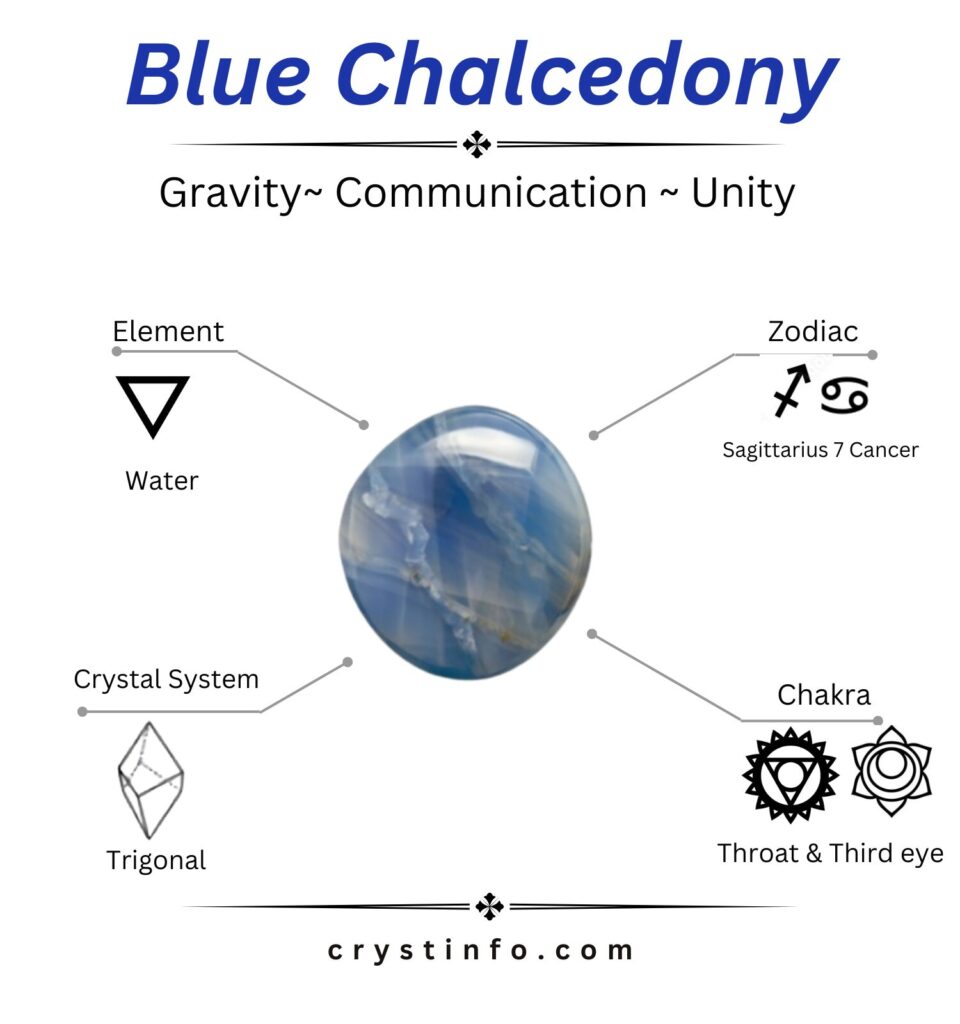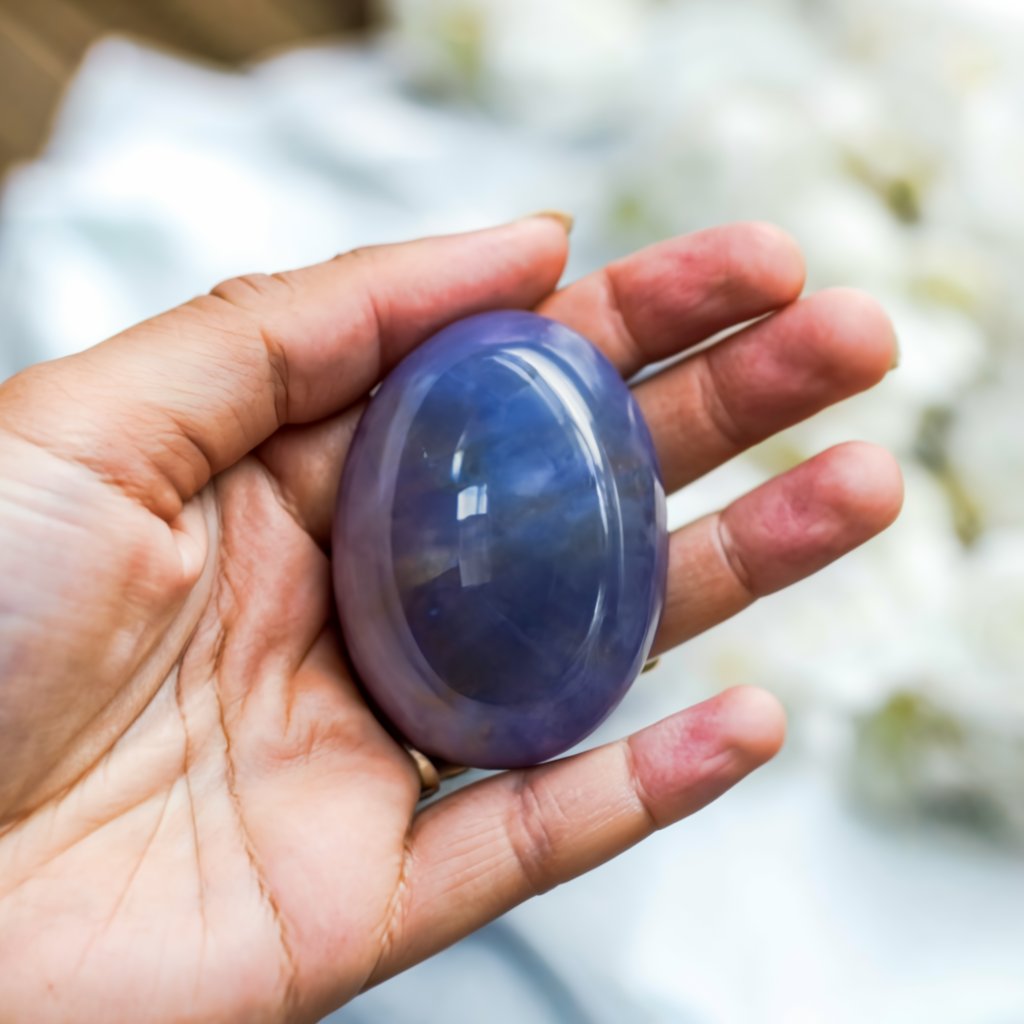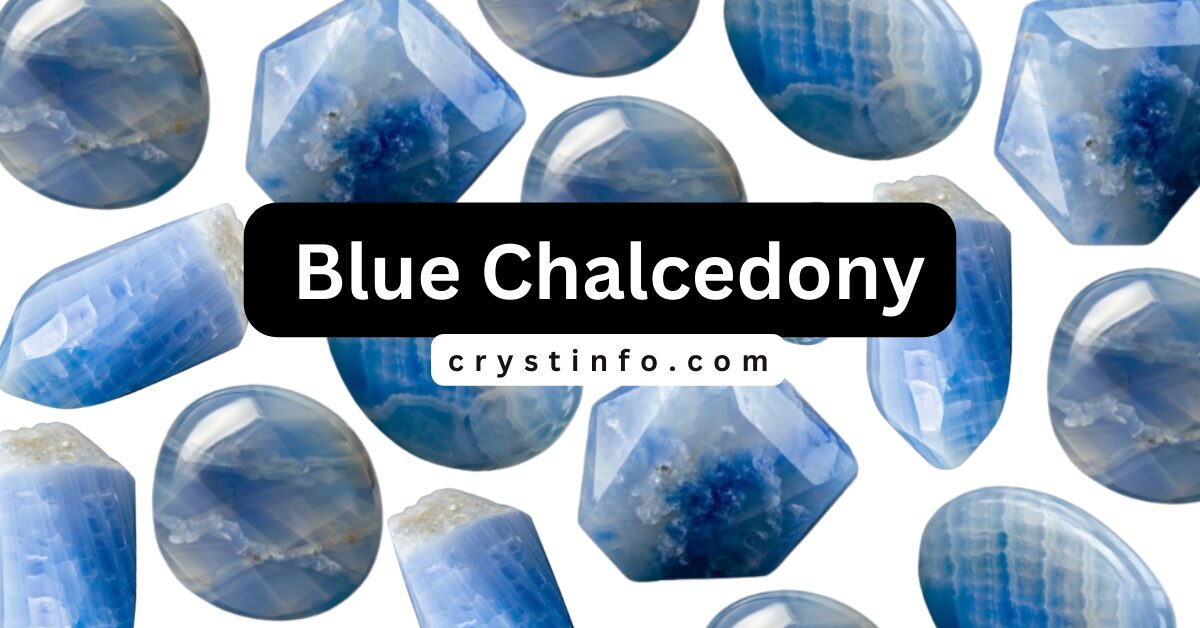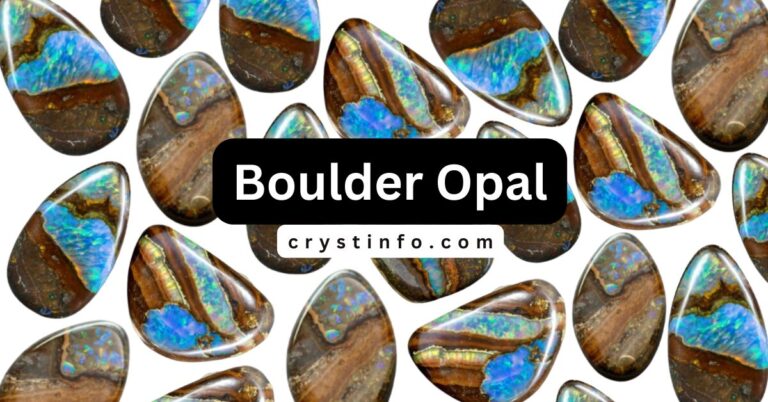Blue Chalcedony: Discover Healing Energies and Meanings
What is Blue Chalcedony?
Blue Chalcedony, a rare translucent blue mineral, is often classified interchangeably as Chalcedony or Agate. Each deposit showcases a slightly nuanced shade of blue, aiding in its distinct identification. Some variants, like “Holly Blue” or “Ellensberg Blue,” boast unique names, while the genuine blue variety from Namibia is typically referred to simply as this Chalcedony. This gemstone serves as a conduit for effective communication, fostering a calm and light-hearted atmosphere. Its energetic influence encourages receptiveness to novel ideas and comprehension of abstract concepts.

- Color Origin:
- This Chalcedony obtains its color from the presence of copper, which imparts it with a unique and captivating blue hue.
- Quartz Family:
- This Chalcedony belongs to the Quartz family and shares its cryptocrystalline structure, which allows it to amplify crystal energy effectively.
- Promotion of Equilibrium:
- Known for its ability to promote equilibrium across various aspects, this Chalcedony balances the conscious mind, inner child, and primal instincts.
- Translucency and Appearance:
- This Chalcedony exhibits a range of translucencies, from semi-transparent to translucent, and is characterized by its waxy luster.
- It comes in various hues, including white, gray, grayish-blue, and shades of brown, with some specimens undergoing dyeing or heating processes to enhance their color.
- Etymology and Historical References:
- The term “Chalcedony” originates from the Latin “chalcedonius,” possibly linked to the town of Chalcedon in Turkey.
- Historical texts like Pliny the Elder’s Naturalis Historia and references in the Book of Revelation mention forms of chalcedony, though their modern correspondence is uncertain.
- Characteristics and Utility:
- Chalcedony is valued for its diversity, affordability, durability, and aesthetic appeal.
- While historically used in crafting tools and weaponry, it now serves primarily as a decorative stone and jewel, reflecting its enduring popularity and versatility.
- Microcrystalline Nature:
- This Chalcedony, as a microcrystalline quartz variant, contains minuscule crystals that are not visible to the naked eye.
- Its distinct blue coloration, attributed to trace amounts of iron and other impurities, makes it a cherished gemstone prized for both its aesthetic and metaphysical properties.
History & Overview:
- Historical Significance:
- This Chalcedony has a rich historical significance, with archaeological findings dating back to 30,000 BCE in the Middle East.
- The name “chalcedony” is derived from the Greek city of Chalcedon, renowned for its high-quality agates and jaspers.
- Composition and Structure:
- This Chalcedony is composed of microscopic quartz crystals and moganite fibers interwoven in a random pattern.
- Its cryptocrystalline nature means that the stone’s crystals are too small to be seen with the naked eye.
- Geological Formation:
- This Chalcedony forms in a wide variety of geological settings, both primary and secondary, as a result of weathering and decomposition of preexisting rocks.
- It is found in igneous, metamorphic, and sedimentary rocks, as well as in various geological environments such as hydrothermal vents, hot springs, and sedimentary basins.
- Versatile Usage:
- Throughout history, this Chalcedony has been utilized for various purposes:
- It has been carved into cameos and intaglios, serving as a source of inspiration for artistic expression.
- This Chalcedony has been widely used in jewelry making as a gemstone, owing to its captivating appearance and metaphysical properties.
- The stone has also been fashioned into dice and other gaming pieces, highlighting its versatility and cultural significance.
- Throughout history, this Chalcedony has been utilized for various purposes:
Meaning:
The power of chalcedony to balance and harmonize the mind, senses, and spirit is well known. Because it is a protective gemstone, it absorbs negative frequencies and energies, stopping them from spreading and fostering a calm and safe environment around it.

- Harmony and Mutual Respect:
- This Chalcedony fosters harmony and mutual respect in society, promoting compassion and understanding, especially in contentious situations.
- It diffuses animosity and creates a relaxed atmosphere, encouraging positive interactions among individuals.
- Emotional Healing:
- The gemstone instills feelings of compassion and kindness while dispelling sadness, fostering happiness, and promoting emotional balance.
- Its meditative properties facilitate introspection, encouraging individuals to focus on positive emotions and experiences, leading to self-forgiveness.
- Therapeutic Qualities:
- Throughout history, Chalcedony has been esteemed for its therapeutic qualities, believed to prevent diseases and enhance nutrient absorption, feminine qualities, and breastfeeding in new mothers.
- Known as the “Speaker’s Stone,” Chalcedony promotes careful reflection and meditation, guiding individuals to consider their words thoughtfully before speaking.
- Nurturing and Absorbing Negative Energy:
- Chalcedony is recognized as a nurturing stone that absorbs and dissipates negative energy, fostering goodwill, brotherhood, and stimulating the mind with new ideas.
- This Chalcedony serves as a reminder to balance emotions and address them constructively, promoting empathy, defusing hostility, and transforming grief into joy.
- Forgiveness and Positive Experiences:
- Through introspection and meditation, this Chalcedony aids in self-forgiveness and the cultivation of positive experiences and emotions, encouraging emotional healing and growth.
| Property | Description |
|---|---|
| Name | Blue Chalcedony |
| Composition | A variety of chalcedony, a form of microcrystalline quartz. |
| Color | Various shades of blue, ranging from pale sky blue to deeper hues. |
| Luster | Waxy to vitreous |
| Transparency | Translucent |
| Hardness | 6.5 to 7 on the Mohs scale |
| Crystal System | Hexagonal |
| Fracture | Conchoidal |
| Cleavage | None |
| Specific Gravity | 2.58 – 2.64 |
| Streak | White |
| Occurrence | Found in various locations worldwide, often in association with volcanic and sedimentary rocks. |
| Uses | – Jewelry: Cut into cabochons or beads for use in necklaces, earrings, and bracelets. |
| – Decorative Use: Carved into ornamental items, figurines, and decorative objects. | |
| – Metaphysical Beliefs: Associated with calmness, communication, and emotional balance. | |
| Care Tips | This Chalcedony is relatively durable but may scratch if not handled with care. Clean with a soft cloth and mild soap. Avoid exposure to harsh chemicals. |
| Spiritual Beliefs | This Chalcedony is believed to have calming and soothing properties, promoting a sense of peace and tranquility. It is associated with the throat chakra and communication. |
| Note | This Chalcedony’s gentle blue hues and smooth texture make it a popular choice for both jewelry and metaphysical practices. It is treasured for its calming energy and serene appearance. |
Hardness:
Gravity:
This Chalcedony is a soothing gemstone known for its calming blue color and gentle energy. It is used in jewelry and decorative items and is believed to promote emotional balance and communication.
Types of Chalcedony:
The cryptocrystalline quartz variety known as chalcedony is prized for its vast array of hues and patterns. Chalcedony comes in a variety of forms, each with special qualities and traits of its own. The following are a few of the most popular varieties of chalcedony:
| Variety | Description |
|---|---|
| Agate | Common and popular variety of chalcedony. Comes in various colors and often displays banded patterns or intricate designs. Used for making cabochons, beads, and carvings. |
| Carnelian | Reddish-orange to orange variety of chalcedony. Known for vibrant color and translucency. Used in jewelry and ornamental objects for centuries. |
| Chrysoprase | Green variety of chalcedony derived from nickel presence. Ranges from pale green to deep apple-green. Valued for attractive green hues and commonly used in jewelry. |
| Onyx | Banded variety of chalcedony, typically featuring black and white bands. Also available in other color combinations like brown, red, or blue. Used for making cameos and beads. |
| Sardonyx | Type of onyx combining brownish-red sard with white bands. Prized for the contrast between rich red and white bands. |
| Moss Agate | Characterized by green to blue-green color. Contains dendritic or moss-like inclusions resembling foliage. Used for cabochons and ornamental carvings. |
| Blue Chalcedony | Known for its soothing blue color. Used in jewelry and believed to have calming properties. |
| Bloodstone | Green chalcedony with red or brown spots. Red spots attributed to iron oxides. Used as a gemstone and for carving. |
| Plasma | Predominantly green chalcedony with red streaks or spots. Less common variety, occasionally used in jewelry. |
| Sagenite | Chalcedony containing needle-like or hair-like mineral inclusions like rutile or goethite. Creates striking patterns within the stone. |
| Prase | Leek-green to dark green variety of chalcedony. Often translucent and used as a gemstone or for carvings. |
Metaphysical Properties:
- Throat Chakra Connection:
- This Chalcedony is associated with the throat chakra, which governs communication and self-expression.
- It helps in finding the right words, promoting clear and effective communication.
- The stone encourages calmness and peace, serving as a potent crystal for anxiety relief.
- Third Eye Chakra Support:
- This Chalcedony is beneficial for the third eye chakra, which is linked to intuition and insight.
- It aids in unblocking the third eye chakra, facilitating trust in one’s instincts and inner wisdom.
- Carrying or wearing Blue Chalcedony enhances the ability to perceive situations clearly and make intuitive decisions.

Metaphysical Properties:
| Aspect | Effects and Benefits |
|---|---|
| Protection | Absorbs negative energy, shields against evil, ill wishes, and negative energies |
| Provides protection during car and plane travel | |
| Guidance | Leads and instructs like a wise mentor, facilitates receiving spiritual messages |
| Allows spiritually guided messages to be available in everyday life | |
| Spiritual Realms | Leads to transition to spiritual realms, navigates exploration of higher dimensions |
| Aids in acquiring wisdom and higher knowledge for life improvement | |
| Psychic Ability | Fosters intuitive communication and understanding, assists in transmitting information |
| Past Life | Facilitates past life recall, induces deep inner healing |
| Helps in resolving and understanding past traumas and experiences | |
| Aura | Strengthens the auric field, shields personal energy from psychic attacks |
| Channeling | Harnesses blue-ray energy for spiritual communication, benefits intuitive readers |
| Spiritual Awakening | Fosters spiritual awakening and growth, connects to the divine for higher knowledge |
| Spiritual Development | Enhances psychic abilities, expands spiritual awareness |
| Improves channeling, intuition, astral travel, and lucid dreaming | |
| Enables recalling and interpreting spiritual messages through dreams and synchronicities |
Physical Healing Properties:
- Pain and Inflammation Relief:
- This Chalcedony is believed to possess properties that aid in relieving pain and inflammation in the body.
- It is often sought after by individuals suffering from conditions such as arthritis, where inflammation and pain are prevalent.
- The soothing energy of this Chalcedony is thought to help alleviate discomfort and promote overall physical well-being.
- Support for Thyroid Health:
- Some practitioners utilize this Chalcedony for its purported benefits in supporting thyroid health.
- While scientific evidence may be limited, believers in crystal healing suggest that the stone’s energies may help balance the thyroid gland’s function.
- This Chalcedony is thought to assist in regulating thyroid hormones and promoting overall thyroid health.
Physical Benefits:
| Body System | Effects and Benefits |
|---|---|
| Energy | Replenishes physical energy; optimizes stamina for work, creative pursuits, and sports |
| Skin | Nourishes skin, improves functions, alleviates pressure and weather sensitivity |
| Tissue | Relieves edema, regenerates mucous membranes, prevents abnormal fluid retention |
| Eye Health | Heals glaucoma, prevents optic nerve damage, regulates eye pressure |
| Immune System | Strengthens immunity, alleviates symptoms from weather changes and allergies |
| Lymphatic System | Anti-inflammatory effect, optimizes lymph nodes, boosts cell replication for defense |
| Circulatory System | Regulates blood pressure and body temperature, ensures proper nutrient distribution |
| Respiratory System | Optimizes respiratory functions, strengthens lungs, assists in proper breathing |
| Dreams | Relaxes mind and body, induces restful sleep, facilitates lucid dreaming |
Emotional Healing Properties:
- Emotional Healing from Loss and Grief:
- This Chalcedony is believed to be beneficial for individuals experiencing loss or grief.
- It is often used as a tool to facilitate emotional healing by encouraging individuals to open up and confront their feelings.
- By releasing negative emotions associated with loss or grief, this Chalcedony helps individuals move forward and embrace life with a positive outlook.
- Addressing Feelings of Jealousy:
- Individuals struggling with feelings of jealousy may find this Chalcedony helpful in managing and overcoming this emotion.
- Jealousy, which can strain relationships and lead to negative consequences, can be addressed by incorporating the properties of this Chalcedony into one’s life.
- The stone’s energy is believed to assist in letting go of jealousy and fostering a more positive perception of relationships, promoting harmony and trust.
| Aspect | Effects and Benefits |
|---|---|
| Comfort | Brings comfort and warm companionship through difficult times |
| Acceptance | Fosters inner child emotional healing, releases emotional blockages and past traumas |
| Self-Confidence | Instills feelings of benevolence, resolves self-limiting beliefs and self-sabotage |
| Inner Peace | Restores balance within the emotional body, resolves emotional conflicts |
| Intuition | Brings clarity, spiritual interpretation, understanding of inner voice |
| Enthusiasm | Instills feelings of excitement and wonder, fosters gratitude for simple things |
| Awareness | Resolves inner critic, facilitates emotional integration, reveals inner truths |
| Creativity | Fosters new ideas and innovative approaches, reinforces enjoyment of life |
| Knowledge | Opens mind to new ideas and information, fosters openmindedness to concepts |
| Communication | Reinforces verbal dexterity, enhances communication skills, facilitates honest conversation |
| Memory | Boosts memory, improves retention and recall of information |
| Kindness | Reinforces peaceful assertiveness, promotes gentleness and kindheartedness |
| Joy | Fortifies constructive self-perception, develops optimistic outlook |
| Patience | Facilitates waiting without resentment, fosters good intentions |
| Calming | Encourages stillness, resolves anger issues, relieves stress and mental pressure |
| Balance | Fosters centeredness, stabilizes emotional energy field, resolves mood swings |
| Wisdom | Facilitates introspection and self-reflection, assists in discovering hidden truths |
Uses:
This chalcedony is used in jewelry, spiritual practices, and ornamental items due to its calming blue color and lovely appearance. The following are some typical applications for blue chalcedony:

| Application | Description |
|---|---|
| Gemstone Jewelry | Frequently used in jewelry design, including rings, necklaces, earrings, bracelets, and pendants. Can be cut into cabochons, faceted stones, beads, and other shapes. |
| Popular choice for both casual and formal jewelry due to its calming and attractive blue color. | |
| Carvings and Cameos | Suitable for carving intricate designs and relief sculptures. Skilled artisans create beautiful carvings featuring scenes, motifs, or patterns. |
| Tumbled Stones | Sometimes tumbled to create smooth, polished stones used as decorative items, worry stones, or in meditation practices. Used for stress relief and relaxation. |
| Metaphysical and Spiritual Practices | Believed to have calming and soothing properties, associated with the throat chakra. Thought to enhance communication, self-expression, and inner peace. Used in meditation. |
| Used as talisman for emotional healing and balance. | |
| Home Decor | Used for decorative purposes in homes and offices. Displayed as polished specimens, used as paperweights, or integrated into decorative items such as tabletops and sculptures. |
| Lapidary Art | Appreciated by lapidaries and artisans for creating custom jewelry pieces, sculptures, and other art forms. Versatile color and translucency can be incorporated into various projects. |
| Collectibles | Rare and high-quality specimens sought after by collectors. Unique patterns and exceptional coloration can add value to collectible pieces. |
| Spiritual and New Age Jewelry | Used in jewelry for spiritual or New Age practices. Believed to promote harmony, reduce stress, and aid in communication. Popular for those who incorporate gemstone energy. |
Chakras:

| Chakra | Effects and Benefits |
|---|---|
| Throat Chakra | Balances and aligns the throat chakra |
| Reinforces speaking authentic feelings and honest truths with compassion | |
| Enables assertiveness without fear of criticism and social judgment | |
| Third-Eye Chakra | Connects with the third eye chakra |
| Improves spiritual learning and understanding of interconnectedness of past, present, and future |
Birthstone and Zodiac Sign:
| Aspect | Description |
|---|---|
| Birthstone | Not a conventional or recent birthstone for any month |
| Zodiac Sign | Intrinsic astrological gemstone for Cancer and Sagittarius |
| Considered a fantastic good fortune gem for Cancers and an exceptionally stabilizing stone for Sagittarians |
Origin:
| Location | Description |
|---|---|
| Namibia | Well-known for producing high-quality this chalcedony, particularly from the Erongo region |
| Highly regarded for its vivid blue color and translucency | |
| Brazil | Significant source of this chalcedony, often found in geodes and nodules |
| The state of Minas Gerais is notable for blue chalcedony deposits | |
| Madagascar | Source of various chalcedony varieties, including blue chalcedony |
| Known for rich blue color, found in different regions of the country | |
| United States | Blue chalcedony found in states like Oregon and California |
| Used by lapidaries and jewelry artisans | |
| India | This chalcedony found in the Deccan Plateau region |
| May vary in color and quality | |
| Other Locations | This chalcedony found in Australia, Mexico, Turkey, and various parts of Africa |
How To Cleanse Chalcedony?
Handling Precautions:
- This Chalcedony is susceptible to scratching and chipping if handled roughly.
- Careful handling is necessary to prevent damage and maintain its integrity over time.
Cleansing Method:
| Cleansing Method | Description |
|---|---|
| Use warm water and mild, unscented soap | Cleanse this Chalcedony using warm water and a mild, unscented soap. |
| Avoid harsh chemicals | Refrain from using harsh chemicals or cleaners that may potentially harm the stone. |
| Gently scrub with a soft cloth or brush | Use a soft cloth or brush to gently scrub the stone and remove dirt or residue. |
| Rinse thoroughly with clean water | After cleaning, ensure to rinse the stone thoroughly with clean water to remove any soap residue and ensure its cleanliness. |
- Protection During Storage:
- Store this Chalcedony in a soft pouch or jewelry box to protect it from scratches and impacts.
- If displaying the stone, consider using a display case or frame with a soft, padded interior.
- Proper storage helps maintain the stone’s properties and prevents unnecessary stress or damage.
Conclusion:
This Chalcedony embodies serenity, communication, and emotional balance, making it a cherished gemstone for millennia. Its calming energy and ability to enhance verbal expression make it a valuable tool for modern living. From ancient civilizations to contemporary practitioners, this Chalcedony continues to inspire harmony and spiritual growth. In essence, it serves as a timeless reminder of the interconnectedness of mind, body, and spirit, offering a pathway to inner peace and authentic self-expression.
FAQs:
1. What is Blue Chalcedony? This Chalcedony is a type of cryptocrystalline quartz that exhibits a distinctive blue hue. It is formed from microscopic crystals of quartz, which give it a smooth and sometimes translucent appearance.
2. How does Blue Chalcedony form? This Chalcedony forms through the deposition of silica-rich solutions in cavities or fissures within rocks. Over time, these solutions solidify, creating the compact and fine-grained structure characteristic of chalcedony.
3. What are the properties of Blue Chalcedony? This Chalcedony is known for its soothing energy and calming effect. It often exhibits a waxy luster and can range in transparency from opaque to semi-translucent. It ranks 6.5-7 on the Mohs scale of hardness.
4. What are the common uses of this Chalcedony? This Chalcedony is frequently used in jewelry making due to its attractive color and relative affordability. It is also believed to possess metaphysical properties, such as promoting emotional balance and communication.
5. Where is Blue Chalcedony found? This Chalcedony can be found in various locations around the world, including Brazil, Uruguay, Namibia, India, and the United States. It forms in sedimentary and volcanic rocks, often near deposits of silica-rich materials.
6. How can this Chalcedony be distinguished from other similar gemstones? This Chalcedony can sometimes be confused with other blue gemstones like blue agate or blue lace agate. However, its distinguishing features include its uniform color and lack of banding, as well as its smooth texture.


![Orange Calcite: Healing Powers and Properties[Guide]](https://crystinfo.com/wp-content/uploads/2023/12/Add-a-heading-24-768x402.jpg)
![[Zodiac Signs]: Unraveling the Mysteries Behind Astrological Signs](https://crystinfo.com/wp-content/uploads/2024/02/Spirit-Quartz-3-768x402.jpg)



![Apache Tears: Unveiling Obsidian Power and [Emotional Transformation]](https://crystinfo.com/wp-content/uploads/2024/01/Chakras-4-768x402.jpg)